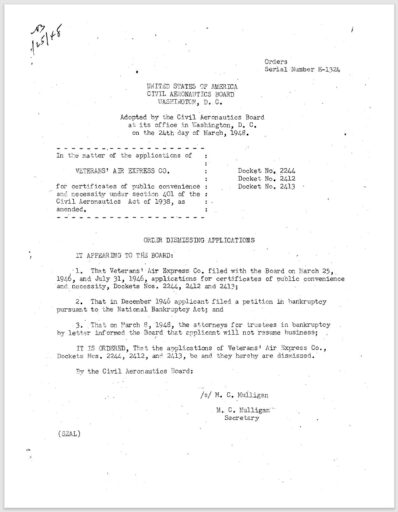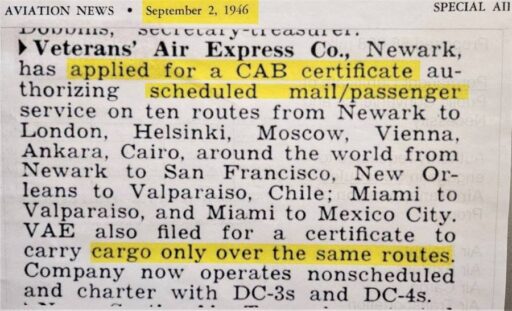Ironic Proof of CAB Applications –
and no CAB responses
In October 2015, an undated CAB Application for worldwide routes surfaced and created more questions than it answered. It was among John Greenleaf, Sr.’s papers. He had spoken about the application with his son, John, Jr, telling him he couldn’t remember why he would have had or kept the document since he had no involvement with that side of Veteran Air business. Fabulous that John Sr. did keep the Application and that John Jr. shared the application with me.
To read the 2015 Post about this as background, click here.

The “plot” thickens
Then a much different document surfaced just this week, only this time it was issued by the CAB on 24 March 1948. Thanks to David Stringer, a valued part of my Research Network, for sharing the “Order Dismissing Applications.” It answers an essential date question and it uncovers a surprising second date. Turns out that Veterans Air Express Co. applied twice for permanent “Certificates of public convenience and necessity” on March 25, 1946 and July 31 of the same year.
But wait! Two more Certificate applications?
There’s something else. An example of the puzzle-pieces nature of this Research. Three days ago, while drafting this Post and double-checking information files, this clipping surfaced from the Special Air Services section of AVIATION NEWS dated September 2, 1946.

While waiting and hoping for CAB approval,
the Vets go about building their “resume” and fleet
On March 25, Veterans Air was:
- 19 days from departure on its first UNRRA contract flight to Prague.
- Under contract for at least five more war-relief flights to Prague, Warsaw (both behind the Iron Curtain) and Athens.
- In possession of and operating a transatlantic-worthy DC-4, four-engine cargo plane.
- Prepared to transport 55,000+ fertilized hatching eggs for which Veterans had designed a heating system and crew procedures that would maintain a constant-temperature of 55 degrees F (airborne and on the ground, day and night) to protect their delicate air cargo as per UNRRA requirements.
By 31 July (date of 2nd CAB application):
- All but one of the UNRRA six flights had been successfully conducted.
- A second DC-4 had been acquired and converted from Army drabs and outfitted by Veterans Air employees, not an outside vendor
- On 10 September 1946, a Crew returned from the last UNRRA contract flight, this one to Athens, having delivered three young breeding stock donated by The Borden Company to help restore the Greek dairy industry.
Foreseeing the future:
- On 24 August 1946, DC-4, NX88003, was delivered to Matson Navigation Co in Oakland, CA, for passenger trans-Pacific outfitting.
- On 20 September 1946, DC-4, N57777, arrived in Oakland at the same facility for the same conversion work.
No CAB response. No work. Just piling debt.
That CAB Certificate was envied, applied for, but seldom if ever granted. It provided hope and a way to operate their businesses free of the non-sked regulation strangle-hold. Veterans Air had the operations experience, two well-suited cargo/passenger DC-4s, and exemplary Army/Navy-trained Crew and Technical staff ready to go.
This 1948 Dismissing Order is the ironic evidence that the CAB never responded. Plus dates evidence that Veterans Air Express Co pursued Bankruptcy in December 1946.
